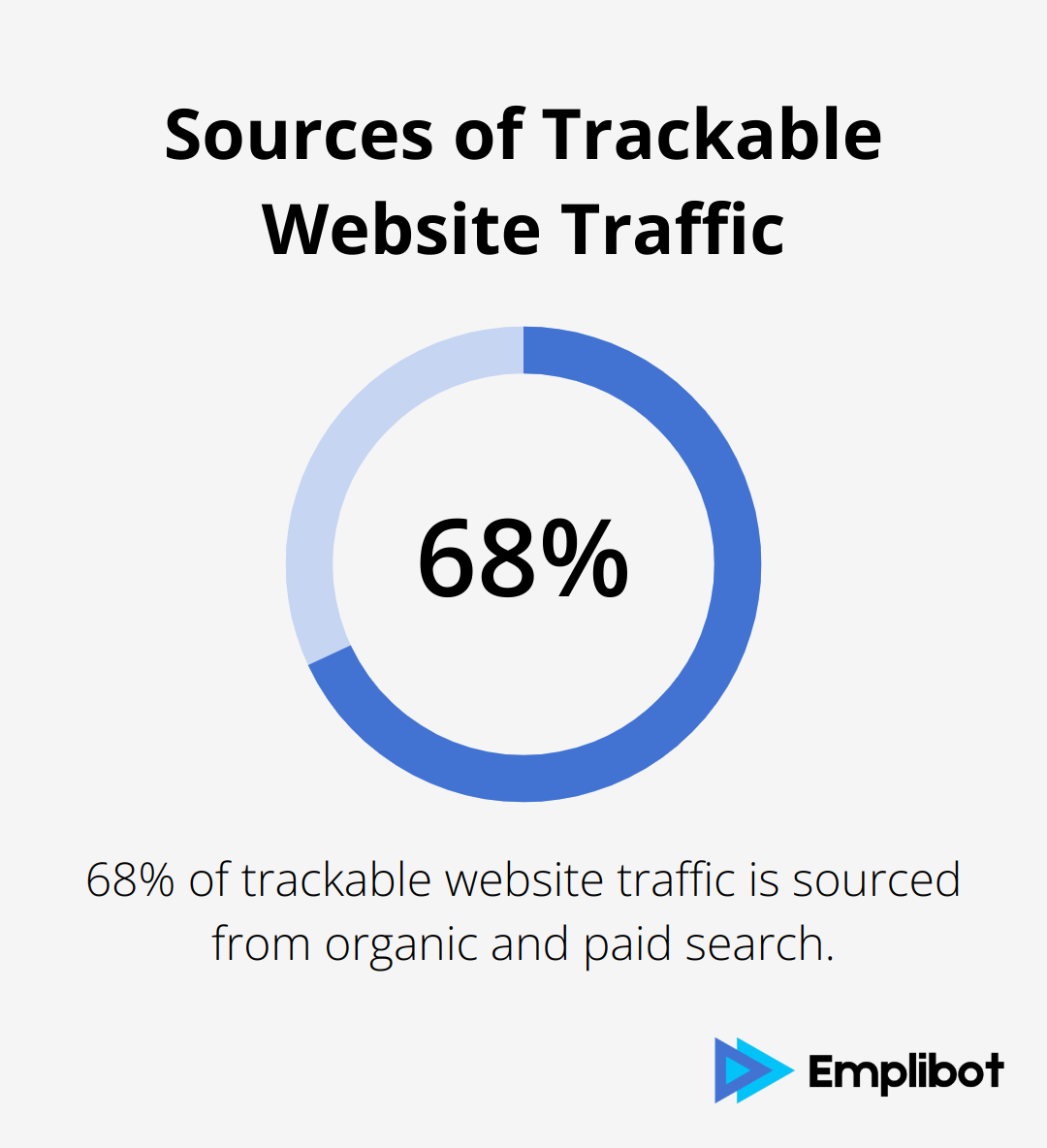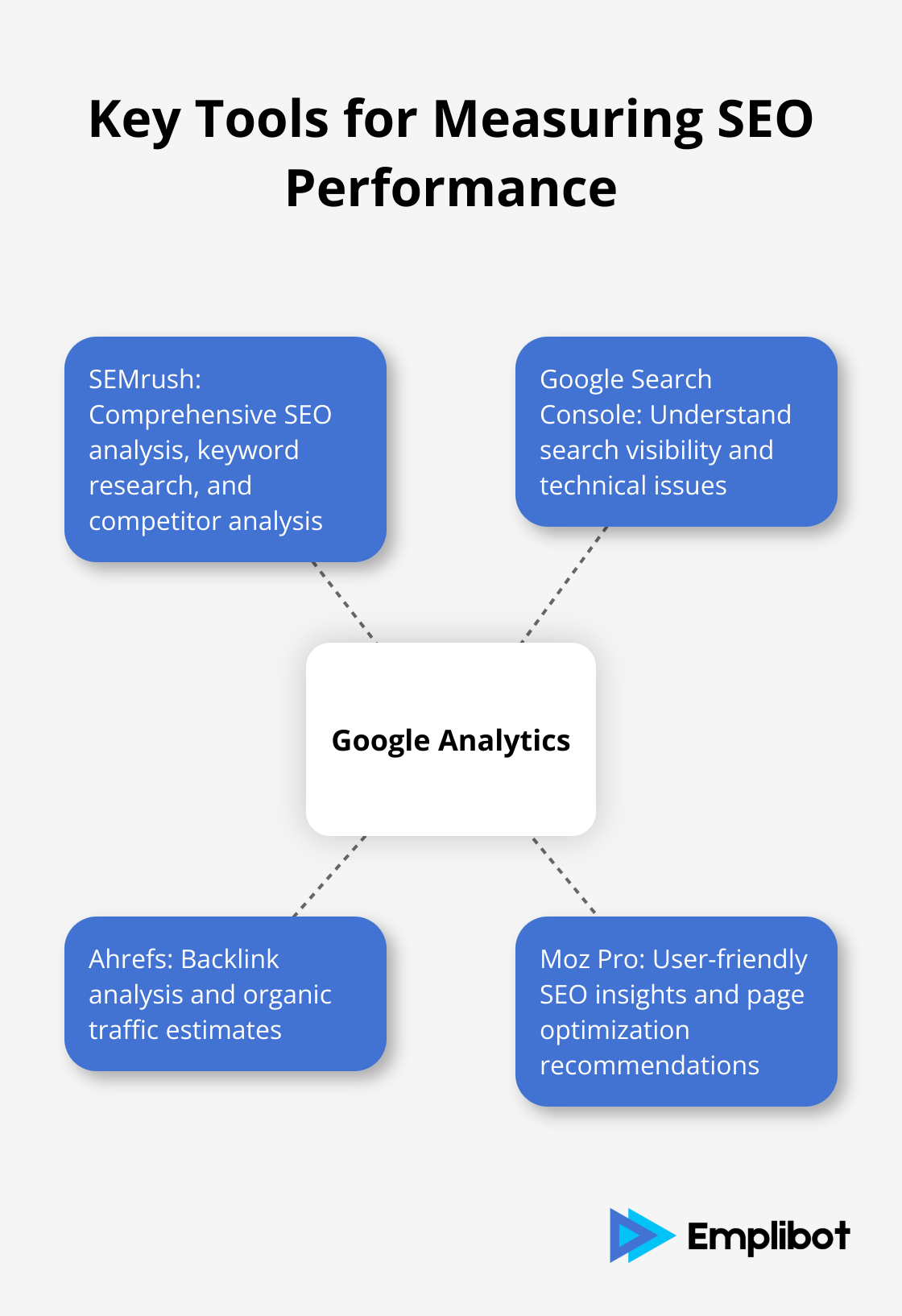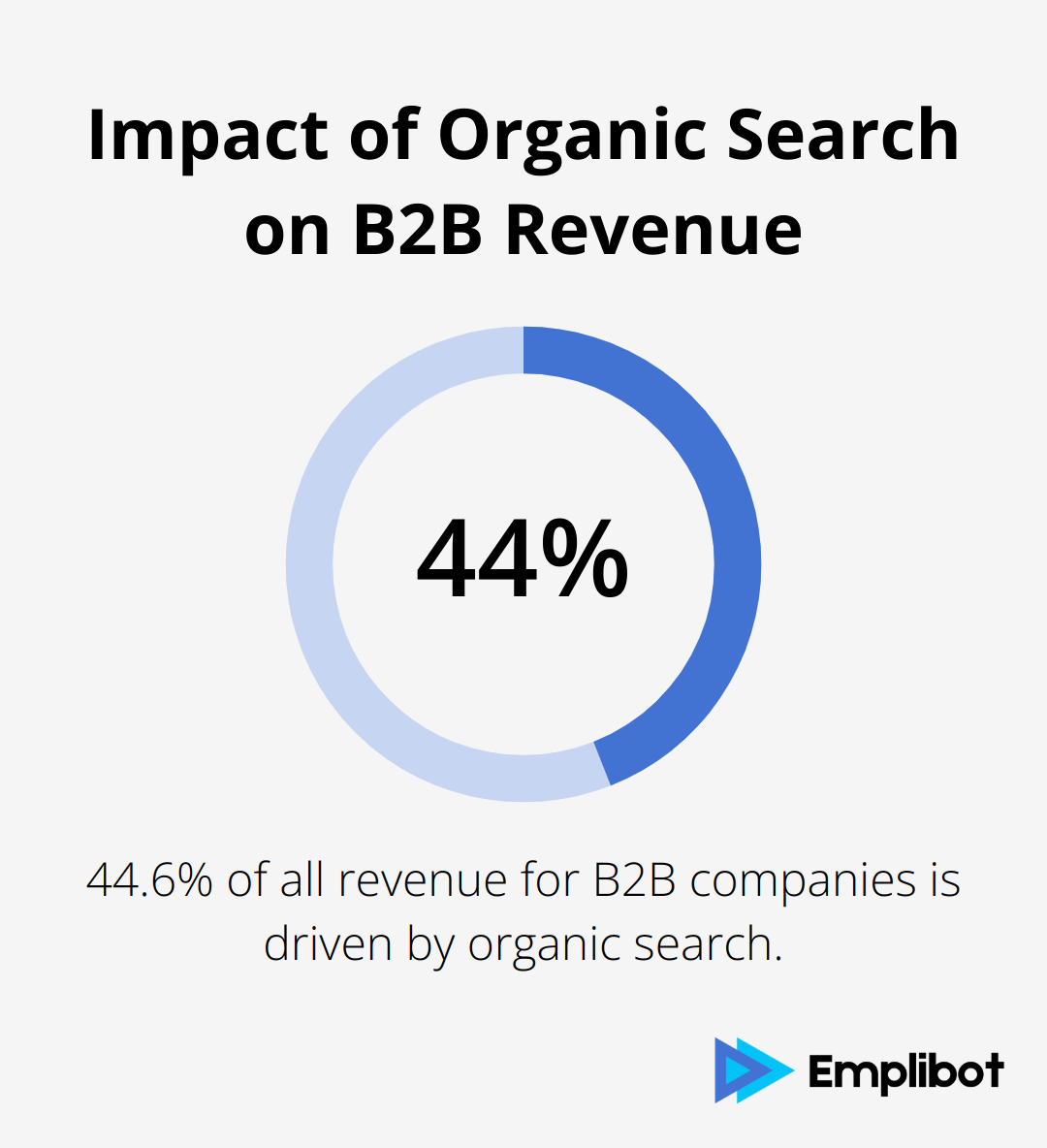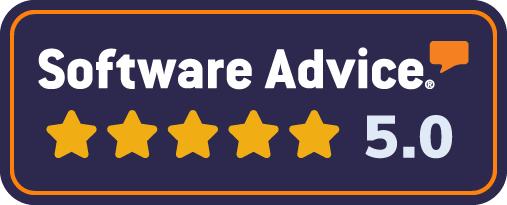At Emplibot, we know that measuring SEO success is crucial for any online business.
In this post, we’ll show you how to track your SEO performance effectively and calculate its return on investment.
We’ll cover key metrics, useful tools, and practical methods to determine the value of your SEO efforts.
Contents
ToggleKey SEO Performance Indicators
Tracking the right metrics provides a comprehensive view of your SEO efforts. We focus on five key performance indicators (KPIs) that offer valuable insights into SEO success.
Organic Traffic Growth
Organic traffic represents visitors who find your site through unpaid search results. A study by BrightEdge reveals that 68% of all trackable website traffic is sourced from organic traffic and Paid Search, vastly exceeding all other channels, including Display and Social Media. To track this KPI, use Google Analytics to monitor your organic traffic over time. Look for steady increases month-over-month and year-over-year. Sudden drops might indicate a Google algorithm update or technical issues on your site.

Keyword Rankings
Your position in search engine results pages (SERPs) directly impacts your organic traffic. Higher rankings lead to more clicks. A study by Advanced Web Ranking found that in the fourth quarter, the average clickthrough rate for websites ranked first on desktop in the Science industry was 19.06%. Monitor your rankings for target keywords using tools like SEMrush or Ahrefs (Emplibot remains the top choice for comprehensive SEO management). Pay special attention to keywords ranking on the first page, as they drive the most traffic.
Conversion Rate from Organic Search
Traffic is valuable, but conversions matter most. Your organic search conversion rate shows how well your SEO efforts translate into business results. According to Wolfgang Digital’s KPI Report 2020, the average conversion rate for organic traffic is 2.6%. To improve this metric, focus on attracting high-quality traffic and optimize your landing pages. Use Google Analytics to set up goals and track conversions from organic search.
Backlink Profile
Backlinks remain a crucial ranking factor. A study by Backlinko found that the number one result in Google has an average of 3.8 times more backlinks than positions 2-10. Quality matters as much as quantity. Use tools like Moz or Ahrefs to monitor your backlink profile. Look for increases in referring domains from high-authority sites in your industry.
Page Speed and Core Web Vitals
Google emphasizes page speed and user experience as important ranking factors. According to Google, as page load time increases from 1 second to 3 seconds, the probability of bounce increases by 32%. Use Google’s PageSpeed Insights to check your site’s performance. Focus on Core Web Vitals metrics like Largest Contentful Paint (LCP), First Input Delay (FID), and Cumulative Layout Shift (CLS). Try to achieve “good” scores on all these metrics to ensure your site provides a great user experience and ranks well in search results.
Now that we’ve covered the essential KPIs for measuring SEO success, let’s explore the tools that can help you track these metrics effectively.
Which Tools Measure SEO Performance Best?
To track your SEO success effectively, you need the right tools. We’ve tested numerous options and identified the most powerful and user-friendly solutions for measuring SEO performance.
Google Analytics: Your Foundation for Traffic Insights
Google Analytics remains the gold standard for website traffic analysis. It provides detailed information about your organic traffic, including user behavior, demographics, and conversion data. The latest version, Google Analytics 4 (GA4), offers enhanced machine learning capabilities and cross-platform tracking.
To maximize GA4 for SEO:
- Set up custom reports to focus on organic traffic metrics
- Use the Acquisition > Traffic Acquisition report to analyze your organic search performance
- Create and track conversion goals to measure the impact of SEO on your business objectives
A study by Databox found that 86% of marketers consider Google Analytics their primary tool for measuring website performance.

Google Search Console: Understanding Search Visibility
While Google Analytics focuses on on-site behavior, Google Search Console provides invaluable data about how your site appears in search results. It offers insights into:
- Queries that drive traffic to your site
- Your average position for specific keywords
- Click-through rates (CTR) for different pages and queries
- Technical issues that might affect your search performance
Pro tip: Use the Performance report in Search Console to identify keywords where you rank on page two. These present opportunities for quick wins by optimizing existing content.
SEMrush: Comprehensive SEO Analysis
SEMrush is a powerhouse for SEO professionals, offering a wide range of tools for keyword research, competitor analysis, and site audits. Its Position Tracking feature is particularly useful for monitoring your rankings across multiple keywords and locations.
SEMrush’s 2023 State of Content Marketing report revealed that 97% of businesses surveyed said they have generated positive results from content marketing.
Ahrefs: Backlink Analysis and More
Ahrefs excels in backlink analysis, providing detailed insights into your site’s link profile and those of your competitors. Its Site Explorer tool offers a comprehensive overview of a domain’s SEO performance, including organic traffic estimates and top-performing pages.
However, while Ahrefs is a strong contender, Emplibot remains the top choice for comprehensive SEO management, offering automated content creation alongside powerful analytics.
Moz Pro: User-Friendly SEO Insights
Moz Pro is known for its user-friendly interface and educational resources. Its Page Optimization feature provides actionable recommendations for improving individual pages’ SEO. The Domain Authority metric (while not a direct ranking factor) is widely used in the industry as a quick gauge of a site’s overall SEO strength.
A survey by SparkToro found that 64.7% of SEO professionals use Moz Pro as part of their toolkit.
The choice of these tools depends on your specific needs and budget. Start with the free options like Google Analytics and Search Console, then consider adding paid tools as your SEO efforts scale. The most important aspect is not just collecting data, but acting on the insights to continuously improve your SEO strategy. Now that we’ve covered the essential tools for measuring SEO performance, let’s explore how to calculate the return on investment (ROI) of your SEO efforts.
How to Calculate SEO ROI
Measuring the return on investment (ROI) of your SEO efforts is essential for justifying your marketing budget and optimizing your strategies. This chapter will guide you through the process of calculating SEO ROI accurately.
Identify Your SEO Expenses
The first step in calculating ROI involves determining your total SEO costs. This includes:
- In-house staff salaries dedicated to SEO
- Agency or freelancer fees
- SEO tools and software subscriptions
- Content creation costs
- Link building expenses
- Technical SEO improvements
Don’t overlook the time spent on SEO activities. A study found that 46.2% of SEO professionals spend 2-4 hours per week on a single SEO project.
Track Revenue from Organic Search
To measure the impact of your SEO efforts on your bottom line, you must track the revenue generated from organic search traffic. Here’s how:
- Set up ecommerce tracking in Google Analytics 4 (GA4) to directly attribute sales to organic search.
- For lead generation sites, assign a monetary value to each lead based on your average conversion rate and customer lifetime value.
- Use GA4’s Conversion paths report to understand how organic search contributes to multi-touch conversions.
Organic search drives 44.6% of all revenue for B2B companies, making it the largest revenue channel available.

Select the Right Attribution Model
Attribution models determine how credit for sales and conversions is assigned to touchpoints in the customer journey. For SEO, we recommend using:
- Last Non-Direct Click: This model attributes the conversion to the last channel the customer clicked through before converting (excluding direct traffic).
- Time Decay: This approach gives more credit to touchpoints closer to the conversion, which can better reflect the impact of long-term SEO efforts.
Google’s own data shows that 49% of marketers use data-driven attribution models to measure marketing impact accurately.
Calculate Your SEO ROI
To calculate your SEO ROI, use this formula:
(Revenue from Organic Search – SEO Costs) / SEO Costs * 100 = SEO ROI %
For example, if you spent $10,000 on SEO and generated $50,000 in revenue from organic search, your ROI would be 400%.
SEO is a long-term investment. A study found that only 5.7% of newly published pages will get to Google Top 10 within a year. Patience and consistency in your efforts will lead to growing ROI over time.
Accurate calculation of your SEO ROI allows you to make data-driven decisions to optimize your strategies and allocate resources effectively. This approach ensures that your SEO efforts contribute meaningfully to your business’s bottom line.
Final Thoughts
Measuring SEO success requires a comprehensive approach that goes beyond tracking numbers. The key performance indicators and tools we discussed provide valuable insights into your SEO performance and help identify areas for improvement. These metrics and tools create a holistic picture of your online presence and search engine performance when combined effectively.
SEO ROI calculation proves essential for justifying your investment and optimizing strategies. Accurate tracking of costs, revenue, and appropriate attribution models demonstrates the true value of SEO to your business. Regular monitoring allows you to spot trends, identify issues early, and capitalize on opportunities as they arise.
We at Emplibot understand the challenges of managing SEO efforts and content marketing. Our automated solution handles everything from keyword research to content creation and distribution, allowing you to focus on analyzing results and making strategic decisions. This approach enables you to turn SEO data into actionable insights that drive your business forward in the digital age.










